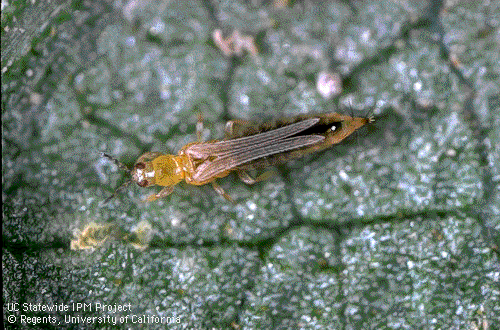Western flower thrips
Frankliniella occidentalis
(Thysanoptera: Thripidae)

Description:
Western flower thrips are slender, very small insects, about 0.03 inch
long when mature. Adults have 4 feathery wings and vary in color from
yellow to dark brown; nymphs are white or pale with small dark eyes.
Biology and damage:
Both nymphs and adult thrips can injure
the plant by rasping the plant bud, flower, leaf tissues and then
sucking the exuding sap. Thrips feeding on strawberry blossoms cause
the stigmas and anthers to turn brown and wither prematurely, but not
before fertilization has occurred. With high popuylaitons, the surface
of the berry may become cracked and discolored (see image). Although the flower
thrips are often numerous on strawberries when catfacing occurs, thrips
do not cause catfacing. This is a result of lygus bug
feeding and possibly other factors. As fruit develops, thrips feeding
may cause a russeting of the fruit around the cap. This type of injury
is seldom
economic.
There can be numerous generations each year. Adults become active in
early spring and deposit their eggs into plant tissues. Full
development from egg to adult takes place in approximately 2 weeks.
Field scouting/monitoring:
Control is not usually necessary
because western flower thrips rarely cause economic damage. Sprays
applied to control thrips disrupt biological
control of other pests such as twospotted spider mites and lygus bugs.
Consider treating only if populations reach 10 thrips per blossom
(UC-Davis). To sample
thrips, place randomly collected flower blossoms into a glass container
charged lightly with ethyl acetate. After at least 30 min, count the
thrips
by removing the blossoms and shaking them onto black paper.
Management:
CHEMICAL CONTROL
Virginia
home
spray
guidelines
California
guidelines
BIOLOGICAL CONTROL:
Minute pirate bugs and other generalist predators can be important
natural enemies of thrips.
